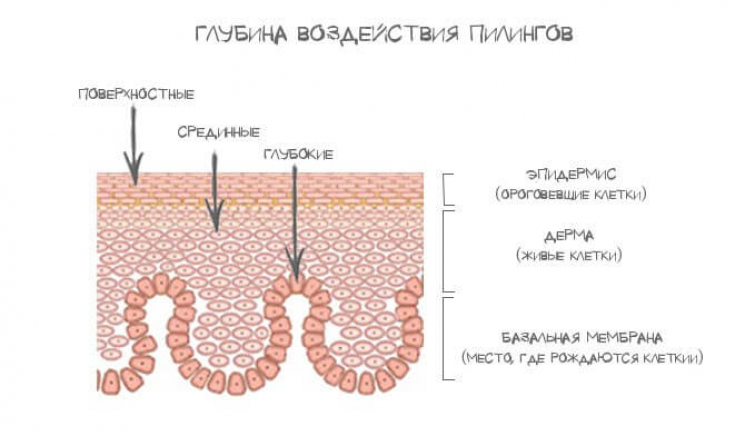Medium depth peels aim to reach the papillary and upper reticular dermis at a depth of approximately 0.45 mm.
In general terms, a concentration of trichloroacetic acid (TCA) 35-50% is used for medium peels. TCA peels significantly improve the appearance of the skin, however, in high concentrations, it can often lead to complications in the form of pigmentation and erythema.
By the 1950s, dermatologists had found several new ingredients to produce mixtures with a lower TCA solution to reduce the risk of side effects and achieve more predictable results.
On estet-portal.com read how you can improve the effectiveness of TCA peel, and achieve a more aesthetic result from the procedure .
- TCA Peel: Perfect skin renewal
- How to improve the effectiveness of TCA peels
- The main complications of median peelingsin
TCA Peel: perfect skin renewal
TCA peel can be used to combat photoaging, in particular for therapy:
- actinic keratosis;
- pigmentation;
- small facial wrinkles and moderate perioral wrinkles.
TCA causes protein denaturation, which leads to keratocoagulation and death of keratinocytes. After re-epithelialization of the skin, collagenogenesis occurs, and previously present abnormal keratinocytes are replaced by new healthy cells.
TCA concentration determines the depth of the peel. A 15-20% TCA concentration will only reach the epidermis, while a 45% TCA solution is likely to penetrate the upper reticular dermis.

Multiple applications of TCA should be considered as an alternative to higher concentrations. For example, multiple applications of 20% TCA at six-week intervals may produce the same effect as a single application of 45%.
Higher high concentrations or repeated applications TCA is better tolerated by patients with thick seborrheic skin than by patients with smooth, thin skin.
Acid peels: the anatomy of a chemical peel
How to improve the effectiveness of TCA peel
- TCA and retinoic acid
Applying 0.025-0.05% retinoic acid just prior to TCA application improves penetration and may provide better results.
The best results for patients with photoaging are achieved in patients with phototype II, although this peel is also effective in patients with phototype III and IV.
TCA is not systemically absorbed and therefore can be safely used in patients with systemic diseases.
- 35% TCA peel in combination with Jessner solution
Jessner's solution consists of:
- resorcinol;
- salicylic acid;
- lactic acid;
- ethanol.
It was first described by American dermatologist Dr. Gary Monheit in 1989.
Jessner's solution breaks down intercellular bridges between keratinocytes, allowing TCA solution (usually 35% is used) to better penetrate the epidermis.
- 35% TCA with 30-70% added glycolic acid
Glycolic acid easily penetrates the skin and has anti-inflammatory, keratolytic and antioxidant effects. Best used before TCA peel.
Various concentrations of glycolic acid (30%-70%) can be used to adjust the peeling intensity. Glycolic peels are generally better tolerated by patients compared to Jessner's solutiona.
Read the most interesting articles in Telegram!
The main complications of median peels
Chemical peels have the potential to cause a number of complications, some of which are easily treatable.
In general, medium depth peels cause fewer complications and less frequently than deep peels because they penetrate more superficially and therefore skin damage is more limited.
There is no risk of systemic complications when using medium peels.
- Reactive hyperpigmentation can occur after chemical peels of any depth.
Treatment of the skin with a combination of hydroquinone creams and retinolfor several weeks prior to peeling may reduce the incidence of hyperpigmentation.
- Bacterial and fungal complications are rare with chemical peels.
- Patients with a positive history of herpes simplex infection should be treated prophylactically with acyclovir or valaciclovir until complete re-epithelialization is achieved, as all peels can reactivate the virus.
What can a chemical peel do in skincare
- Factors contributing to the likelihood of scarring after peeling are not yet well understood.
However, delayed healing and persistent redness may precede scarring.
- Acne after a chemical peel can appear immediately after re-epithelialization and is not a rare complication.
This may be due to the aggravation of pre-existing acne or due to the overuse of fatty preparations.
Short-term use of systemic antibiotics, together with the cessation of skin care use of any oily products, will usually improve the skin condition quickly.







Add a comment